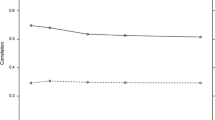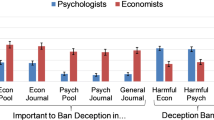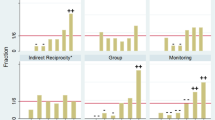Abstract
Studying the likelihood that individuals cheat requires a valid statistical measure of dishonesty. We develop an easy empirical method to measure and compare lying behavior within and across studies to correct for sampling errors. This method estimates the full distribution of lying when agents privately observe the outcome of a random process (e.g., die roll) and can misreport what they observed. It provides a precise estimate of the mean and confidence interval (offering lower and upper bounds on the proportion of people lying) over the full distribution, allowing for a vast range of statistical inferences not generally available with the existing methods.

Similar content being viewed by others
Notes
Rigdon and d’Esterre (2015) were able to observe the true outcome subjects observed. In personal correspondence, the authors informed us that not a single subject lied when reporting the lower monetary outcome. Using a Bluetooth enabled die that covertly transmits the observed outcome of each roll to the experimenter, Kröll et al. (Kröll and Rustagi 2016) were also able to observe the prevalence of underreporting. In personal communication, they reported that underreporting occurred in only 9 cases out of 2880 (0.3%). It is possible to relax our assumption of no underreporting (e.g., we could allow for decision error, so that with probability εj j reports an outcome that a subject did not intend to report). We leave this for future research not only because we expect that decision errors are rare given the simplicity of the task, but also since we expect decision errors would be symmetric and thus only minimally affect the implications on our analysis.
In personal correspondence, David Hugh–Jones notes that our adjustment of the denominator can over-estimate the percent of lying when the sample is small and when the true percent of subjects who lie is also small. A Bayesian approach and Maximum-Likelihood estimation may correct this bias, but is beyond the scope of this paper.
Researchers may also be interested in partial lying (e.g., to examine how many subjects lie from one outcome xk to xj (k < j)) to measure small vs. big lies. We believe that the techniques to estimate partial lies can be developed from the method presented in this paper, but leave it for future work as it requires technical sophistication beyond the scope of this paper.
Given R = 60 subjects out of the N = 100 subjects reported the higher outcome, we assume that the highest possible percent who could have been dishonest is 60%.
Keeping the same example as presented in Sect. 2, consider the case where only one out of four subjects report the high outcome after tossing a coin. Other methods conclude that there is no lying (assuming no downward lying). Our method accounts for the fact that it may have occurred that no subject actually observed the high outcome (with a 6.25% probability) or that only one subject observed the high outcome, and thus, nobody lied. Our method predicts a proportion of liars of 5% (a 6.25% chance that 25% of the subjects lied plus a 25% chance that no subjects lied) with a 95% confidence interval from 0 to 25%.
It remains that, as shown by Cohn et al. (2014), the success rate reported by the bankers whose identity was primed was significantly higher than the success rate reported by the control group.
We are not able to include Type 2 error calculations for the existing methods, since, as noted previously, the existing methods do not provide any distribution to determine confidence intervals beyond the expected mean lying rates, and thus, there is no basis to determine whether these methods’ estimates of the lying rate are (or are not) close to the true lying rates that generated the data.
In further simulations not shown here, if the sample size increases to N = 1,000 subjects, the percent of Type 2 errors further decreases for all the levels of Q explored here, but this does not appear to be of practical interest, since most research budgets would not extend to that many subjects.
References
Abeler, J., Nosenzo, D., & Raymond, C. (2016). Preferences for truth-telling. IZA Discussion Papers 10188. Institute for the Study of Labor (IZA)
Banerjee, R., Gupta, N. D., & Villeval, M. C. (2017). The spillover effects of affirmative action on competitiveness and unethical behavior. European Economic Review, 101, 567–604.
Benndorf, V., Moellers, C., & Normann, H. T. (2017). Experienced vs. inexperienced participants in the lab: Do they behave differently? Journal of the Economic Science Association, 3(1), 12–25.
Cohn, A., Fehr, E., & Maréchal, M. A. (2014). Business culture and dishonesty in the banking industry. Nature, 516(7529), 86–89.
Cohn, A., Maréchal, M. A., & Noll, T. (2015). Bad boys: how criminal Identity salience affects rule violation. Review of Economic Studies, 82(4), 1289–1308.
Fischbacher, U., & Föllmi-Heusi, F. (2013). Lies in disguise—an experimental study on cheating. Journal of the European Economic Association, 11(3), 525–547.
Garbarino, E., Slonim, R., & Villeval, M. C. (2017). Loss aversion and lying behavior: theory, estimation and empirical evidence (July 2017). GATE Working Paper no 1631. Available at SSRN: https://ssrn.com/abstract=2876636.
Houser, D., Vetter, S., & Winter, J. (2012). Fairness and cheating. European Economic Review, 56, 1645–1655.
Jacobsen, C., & Piovesan, M. (2016). Tax me if you can: an artefactual field experiment on dishonesty. Journal of Economic Behavior & Organization, 124, 7–14.
Kröll, M., & Rustagi, D. (2016). Shades of dishonesty and cheating in informal milk markets in India. SAFE Working Paper, 134, Goethe University, Frankfurt.
Moshagen, M., & Hilbig, B. E. (2017). The statistical analysis of cheating paradigms. Behavioral Research, 49, 724–732.
Rigdon, M. L., & D’Esterre, A. P. (2015). The effect of competition on the nature of cheating behavior. Southern Economic Journal, 81(4), 1012–1024.
Shalvi, S., Dana, J., Handgraaf, M. J., & De Dreu, C. K. (2011). Justified ethicality: observing desired counterfactuals modifies ethical perceptions and behavior. Organizational Behavior and Human Decision Processes, 115, 181–190.
Acknowledgements
We are grateful to an Associate Editor and two anonymous reviewers for very useful comments and to Quentin Thevenet for assistance. Financial support from the University of Sydney and the FELIS program of the French National Agency for Research (ANR14-CE28-0010-01) is gratefully acknowledged. This research was performed within the framework of the LABEX CORTEX (ANR-11-LABX-0042) of Université de Lyon, within the program Investissements d’Avenir (ANR-11-IDEX-007) operated by the French National Research Agency (ANR).
Author information
Authors and Affiliations
Corresponding author
Rights and permissions
About this article
Cite this article
Garbarino, E., Slonim, R. & Villeval, M.C. A method to estimate mean lying rates and their full distribution. J Econ Sci Assoc 4, 136–150 (2018). https://doi.org/10.1007/s40881-018-0055-4
Received:
Revised:
Accepted:
Published:
Issue Date:
DOI: https://doi.org/10.1007/s40881-018-0055-4





